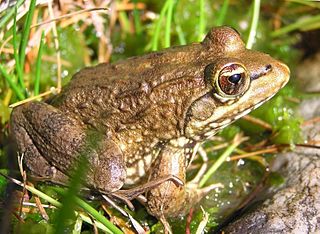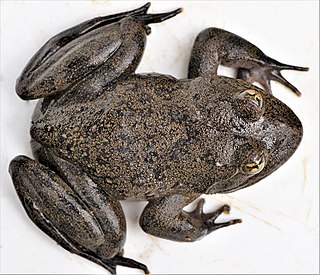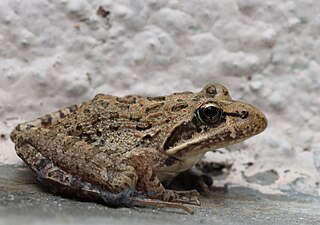
Leptopelis flavomaculatus is a species of frog in the family Arthroleptidae. It is found in the lowlands eastern and southern Africa, from Mozambique north of the Save River and Zimbabwe to Malawi, eastern Tanzania, and coastal Kenya. Its common names are yellow-spotted tree frog, brown-backed tree frog, brown forest treefrog, and Johnston's treefrog.
Craugastor chrysozetetes is a possibly extinct species of frog in the family Craugastoridae. It is endemic to Honduras where it is only known from near its type locality on the Cerro Búfalo, Cordillera de Nombre de Dios, at the edge of the Pico Bonito National Park. Common name McCranie's robber frog has been coined for this species. However, James McCranie himself has argued that this name "should be rejected in favor of a name associated with the type locality instead of a name tied to one of the three authors who named this species".
Niceforonia dolops is a species of frog in the family Strabomantidae. It is found in the Andes of southern Colombia and northern Ecuador. Specifically, it is known from the Cordillera Oriental and Colombian Massif in Caquetá and Putumayo Departments, Colombia, and Napo Province, Ecuador. Common name Putumayo robber frog has been coined for it.

The Hogsback frog, or Rattray's forest frog, is a species of frog in the family Pyxicephalidae. It is one of three species within the genus Anhydrophryne. It is endemic to the Eastern Cape province of South Africa.

Arthroleptella subvoce is a species of frogs in the family Pyxicephalidae. It is endemic to South Africa and only known from the Groot Winterhoek Wilderness Area, Western Cape. Common name northern moss frog has been coined for it. The specific name subvoce is Latin for "under voice" and refers to the very subdued male advertisement call of this frog.

The micro frog, or Cape Flats frog, is a species of frog less than 2 cm (0.8 in) long in the family Pyxicephalidae, in the monotypic genus Microbatrachella. Its color varies from rufous brown with dark mottling, to tan or green, depending on the population. It is endemic to the south-western Cape area of South Africa, with a single population found on the Cape Flats of Cape Town and several populations on the eastern side of False Bay. It typically lives in wetlands in coastal fynbos habitats, but its total area of occupancy is very small, and the International Union for Conservation of Nature has rated it as being "critically endangered".

Petropedetes cameronensis, sometimes known as the Cameroon water frog, is a species of frog in the family Petropedetidae. It is found in southeastern Nigeria, southwestern Cameroon, and on the island of Bioko. It is the type species of the genus Petropedetes.
Petropedetes perreti is a species of frog in the family Petropedetidae. It is endemic to Cameroon. It is known from the southern slopes of the Bamiléké Plateau, Mount Manengouba, and Mount Nlonako. Common name Perret's water frog has been coined for it.

The Cape river frog is a species of frog in the family Pyxicephalidae named for the Cape of Good Hope. Formerly, it was placed in the family Ranidae. It occurs widely in the Eastern Cape and Western Cape provinces of South Africa. A newly described species, A. poyntoni, was split from this species in 2013.
Amietia ruwenzorica is a species of frog in the family Pyxicephalidae. It is found in the eastern Democratic Republic of the Congo and western Uganda, including the eponymous Rwenzori Mountains on the Uganda/DRC border as well as Kabobo Plateau and Itombwe Mountains in DRC.

Amietia wittei is a species of frog in the family Pyxicephalidae. It is found in Kenya and Tanzania, including Mount Elgon in the Kenya/Uganda border region. Its type locality is in Molo, Kenya, located near the top of the Mau Escarpment. The specific name wittei honours Gaston-François de Witte, a Belgian naturalist.

Amietia vertebralis, also known as Maluti river frog, aquatic river frog, ice frog, large-mouthed frog, or water frog, is a species of frogs in the family Pyxicephalidae. It is an aquatic high-altitude species found in Lesotho and neighbouring South Africa.

Amietia is a genus of frogs, commonly known as large-mouthed frogs or river frogs, in the family Pyxicephalidae. They are endemic to central and southern Africa. Formerly, the genus was named Afrana and was placed in the family Ranidae.

The African bullfrog, also known as the giant bullfrog or the South African burrowing frog, is a species of frog in the family Pyxicephalidae. It is also known as the pixie frog due to its scientific name. It is found in Angola, Botswana, Kenya, Malawi, Mozambique, Namibia, South Africa, Tanzania, Uganda, Zambia, Zimbabwe, and possibly the Democratic Republic of the Congo. It has been extirpated from Eswatini. It has long been confused with the edible bullfrog, and species boundaries between them, including exact range limits, are not fully understood. Additionally, P. angusticeps of coastal East Africa only was revalidated as a separate species in 2013.

The edible bullfrog, also known as the pixie frog, lesser bullfrog or Peter's bullfrog, is a large-bodied African species of frog in the family Pyxicephalidae.

Gray's stream frog is a fairly small species of frog in the family Pyxicephalidae. It is a ground dweller, living mainly in vegetation such as sedges, generally brown, slenderly built and agile, with long, practically unwebbed toes.
Amietia hymenopus is a species of frog in the family Pyxicephalidae. It is found in the Drakensberg Mountains and Lesotho Highlands in northeastern Lesotho and adjacent South Africa. This species has many common names: Phofung river frog, Berg stream frog, Drakensberg river frog, Natal Drakensberg frog, Drakensberg frog, and Drakensberg rana.

Delalande's sand frog, also known as Delalande's frog, Cape sand frog, or striped pixie, is a species of frog in the family Pyxicephalidae. It is endemic to western and southern South Africa and occurs in the low-lying areas of Namaqualand, Western Cape, and Eastern Cape as far east as Cape St. Francis.

Tandy's sand frog is a species of frog in the family Pyxicephalidae. It is found in South Africa, Botswana, Namibia, and south-western Angola, and from inland Tanzania and Kenya. It probably occurs more widely within and between these two disjunct areas. The specific name tandyi honours Robert Mills Tandy, an American biologist, herpetologist, and photographer and the collector of the type material.

Amietia desaegeri is a species of frog in the family Pyxicephalidae. It is found west and south of the Rwenzori Mountains in eastern Democratic Republic of the Congo and north-western Rwanda. The common names Byangolo frog and De Saeger's river frog have been coined for it.
















